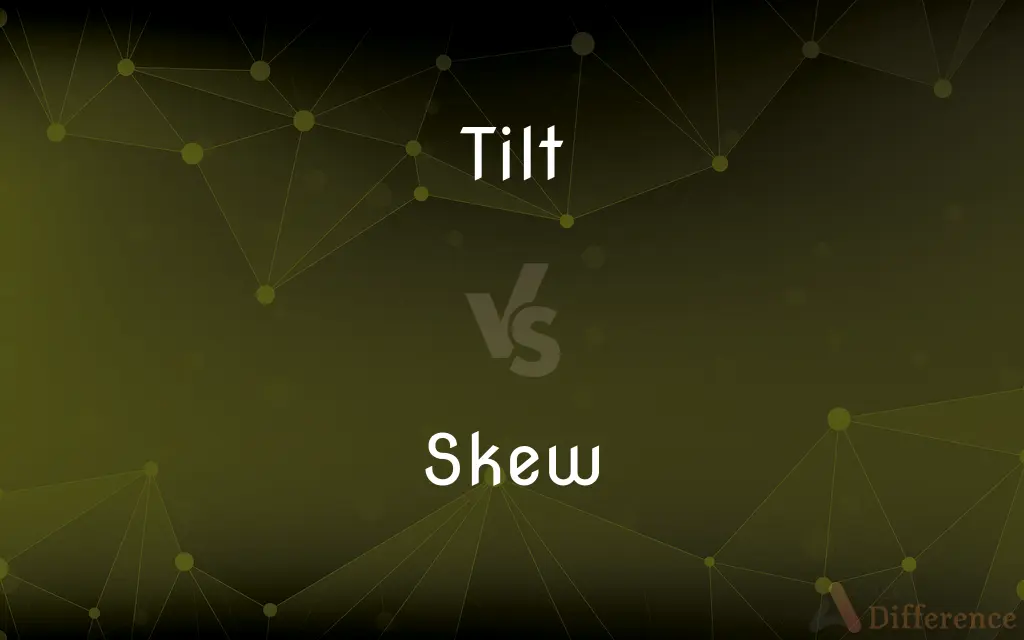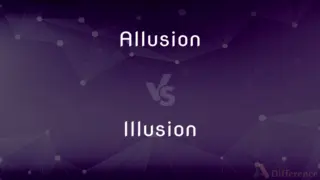Tilt vs. Skew — What's the Difference?
By Maham Liaqat & Urooj Arif — Updated on April 14, 2024
Tilt involves a rotation along one axis, creating an angular displacement, while skew distorts by shifting lines in parallel but at differing angles.

Difference Between Tilt and Skew
Table of Contents
ADVERTISEMENT
Key Differences
Tilt refers to an angular adjustment or inclination from a vertical or horizontal line, suggesting a simple rotation. On the other hand, skew involves a transformation where an object’s lines or axes are shifted in a non-uniform manner, altering the original alignment without rotation.
When an object tilts, it moves around a fixed axis, often seen in the tilting of a camera or a head nod. Whereas skewing adjusts elements in a way that angles between them and their original coordinates change, commonly used in graphic design to create perspective or depth.
Tilt can be easily visualized as a one-dimensional rotation in either a vertical or horizontal direction. In contrast, skew typically impacts two dimensions, shifting points along an axis in a way that the dimensions are not uniformly adjusted.
Applications of tilt are commonly found in photography and aviation, where precise angles are crucial. On the other hand, skew is frequently used in typography and 3D modeling, where elements are adjusted to create visual effects or corrections.
Understanding tilt is about grasping the concept of rotational movement around an axis. Skew, however, involves understanding how objects or elements can be manipulated to appear as if they are in a different orientation without actually rotating them.
ADVERTISEMENT
Comparison Chart
Definition
Rotation about an axis
Distortion by shifting lines at various angles
Dimensions
Typically involves one-dimensional rotation
Involves adjustments in two dimensions
Visualization
Seen as a pivot from a fixed point
Seen as sliding lines parallel at angles
Applications
Used in photography, aviation
Used in graphic design, typography
Movement
Angular adjustment around a central axis
Lines move parallel, altering shape
Compare with Definitions
Tilt
To cause to lean, incline, slope, or slant.
Tilt the bucket to pour the water out.
Skew
In statistics, lack of symmetry in a distribution.
A positive skew in data shows a tail on the right side.
Tilt
In video gaming, a mechanic to control angle or orientation.
Use the joystick to tilt the camera angle.
Skew
To turn or place at an angle.
Skew the mirror slightly to avoid direct sunlight.
Tilt
A jousting contest in medieval tournaments.
Knights would compete in the tilt, charging at each other with lances.
Skew
In computing, the misalignment of data or timing.
The data was skewed due to asynchronous transmission.
Tilt
A sloping position or movement.
He adjusted the tilt of his hat to shield his eyes from the sun.
Skew
To distort or cause to be misleading.
The skewed presentation gave a false impression of the facts.
Tilt
In pinball, a movement causing the machine to register a fault.
Too much tilt during play triggered the game's tilt sensor.
Skew
In typography, to slant the orientation of text.
Skew the text for a dynamic effect on the poster.
Tilt
Move or cause to move into a sloping position
The floor tilted slightly
He tilted his head to one side
Skew
To turn or place at an angle
Skew the cutting edge of a plane.
Tilt
(in jousting) thrust at with a lance or other weapon
The lonely hero tilting at the system
He tilts at his prey
Skew
To give a bias to; distort
The use of a limited sample skewed the findings of the study.
Tilt
A sloping position or movement
The tilt of her head
Skew
To take an oblique course or direction.
Tilt
A combat for exercise or sport between two men on horseback with lances; a joust.
Skew
To look obliquely or sideways.
Tilt
A small hut in a forest.
Skew
To display a statistical tendency toward
A television program that skews toward teenagers.
Tilt
To cause to slope, as by raising one end; incline
Tilt a soup bowl.
Tilt a chair backward.
Skew
Placed or turned to one side; asymmetric.
Tilt
To cause to be advantageous to one party rather than another
A development that tilted the balance of trade in their favor.
Skew
Distorted or biased in meaning or effect.
Tilt
To aim or thrust (a lance) in a joust.
Skew
Having a part that diverges, as in gearing.
Tilt
To charge (an opponent); attack.
Skew
(Mathematics) Neither parallel nor intersecting. Used of straight lines in space.
Tilt
To forge with a tilt hammer.
Skew
(Statistics) Not symmetrical about the mean. Used of distributions.
Tilt
To slope; incline
The field tilts toward the river.
Skew
An oblique or slanting movement, position, or direction.
Tilt
To have a preference, favor, or be inclined toward something
She recently tilted toward vegetarianism.
Skew
(transitive) To form or shape in an oblique way; to cause to take an oblique position.
Tilt
To be advantageous to one side over another, as in a dispute
"The battle ... was beginning to tilt again in the Confederates' favor" (Stephen W. Sears).
Skew
(statistics) To cause (a distribution) to be asymmetrical.
Tilt
To fight with lances; joust.
Skew
(transitive) To bias or distort in a particular direction.
A disproportionate number of female subjects in the study group skewed the results.
Tilt
To engage in a combat or struggle; fight
Tilting at injustices.
Skew
To hurl or throw.
Tilt
To cover (a vehicle) with a canopy or an awning.
Skew
(intransitive) To move obliquely; to move sideways, to sidle; to lie obliquely.
Tilt
The act of tilting or the condition of being tilted.
Skew
(intransitive) To jump back or sideways in fear or surprise; to shy, as a horse.
Tilt
An inclination from the horizontal or vertical; a slant
Adjusting the tilt of a writing table.
Skew
(intransitive) To look at obliquely; to squint; hence, to look slightingly or suspiciously.
Tilt
A sloping surface, as of the ground.
Skew
(not comparable) Neither parallel nor perpendicular to a certain line; askew.
A skew arch
Tilt
A tendency to favor one side in a dispute
The court's tilt toward conservative rulings.
Skew
Of two lines in three-dimensional space: neither intersecting nor parallel.
Tilt
A preference, inclination, or bias
"pitilessly illuminates the inaccuracies and tilts of the press" (Nat Hentoff).
Skew
Of a distribution: asymmetrical about its mean.
Tilt
A medieval sport in which two mounted knights with lances charged together and attempted to unhorse one another.
Skew
(rare) Askew, obliquely; awry.
Tilt
A thrust or blow with a lance.
Skew
Something that has an oblique or slanted position.
Tilt
A combat, especially a verbal one; a debate.
Skew
An oblique or sideways movement.
Tilt
A tilt hammer.
Skew
A squint or sidelong glance.
Tilt
New England See seesaw.
Skew
A kind of wooden vane or cowl in a chimney which revolves according to the direction of the wind and prevents smoking.
Tilt
A canopy or an awning for a boat, wagon, or cart.
Skew
A piece of rock lying in a slanting position and tapering upwards which overhangs a working-place in a mine and is liable to fall.
Tilt
(transitive) To slope or incline (something); to slant.
Tilt the barrel to pour out its contents.
Skew
A bias or distortion in a particular direction.
Tilt
(intransitive) To be at an angle.
Skew
(electronics) A phenomenon in synchronous digital circuit systems (such as computers) in which the same sourced clock signal arrives at different components at different times.
Tilt
To charge (at someone) with a lance.
Skew
(statistics) A state of asymmetry in a distribution; skewness.
Tilt
(transitive) To point or thrust a weapon at.
Skew
(architecture) A stone at the foot of the slope of a gable, the offset of a buttress, etc., cut with a sloping surface and with a check to receive the coping stones and retain them in place; a skew-corbel.
Tilt
(transitive) To point or thrust (a weapon).
Skew
The coping of a gable.
Tilt
To forge (something) with a tilt hammer.
To tilt steel in order to render it more ductile
Skew
One of the stones placed over the end of a gable, or forming the coping of a gable.
Tilt
To intentionally let the ball fall down to the drain by disabling flippers and most targets, done as a punishment to the player when the machine is nudged too violently or frequently.
Skew
Awry; obliquely; askew.
Tilt
To play worse than usual (often as a result of previous bad luck or losses).
Skew
Turned or twisted to one side; situated obliquely; skewed; - chiefly used in technical phrases.
Tilt
(transitive) To cover with a tilt, or awning.
Skew
A stone at the foot of the slope of a gable, the offset of a buttress, or the like, cut with a sloping surface and with a check to receive the coping stones and retain them in place.
Tilt
A slope or inclination.
Skew
To walk obliquely; to go sidling; to lie or move obliquely.
Child, you must walk straight, without skewing.
Tilt
The inclination of part of the body, such as backbone, pelvis, head, etc.
Skew
To start aside; to shy, as a horse.
Tilt
(photography) The controlled vertical movement of a camera, or a device to achieve this.
Skew
To look obliquely; to squint; hence, to look slightingly or suspiciously.
Tilt
A jousting contest. (countable)
Skew
To shape or form in an oblique way; to cause to take an oblique position.
Tilt
An attempt at something, such as a tilt at public office.
Skew
To throw or hurl obliquely.
Tilt
A thrust, as with a lance.
Skew
Turn or place at an angle;
The lines on the sheet of paper are skewed
Tilt
A tilt hammer.
Skew
Having an oblique or slanting direction or position;
The picture was skew
Tilt
A canvas covering for carts, boats, etc.
Tilt
Any covering overhead; especially, a tent.
Tilt
A covering overhead; especially, a tent.
Tilt
The cloth covering of a cart or a wagon.
Tilt
A cloth cover of a boat; a small canopy or awning extended over the sternsheets of a boat.
Tilt
A thrust, as with a lance.
Tilt
A military exercise on horseback, in which the combatants attacked each other with lances; a tournament.
Tilt
See Tilt hammer, in the Vocabulary.
Tilt
Inclination forward; as, the tilt of a cask.
Tilt
To cover with a tilt, or awning.
Tilt
To incline; to tip; to raise one end of for discharging liquor; as, to tilt a barrel.
Tilt
To point or thrust, as a lance.
Sons against fathers tilt the fatal lance.
Tilt
To point or thrust a weapon at.
Tilt
To hammer or forge with a tilt hammer; as, to tilt steel in order to render it more ductile.
Tilt
To lean; to fall partly over; to tip.
The trunk of the body is kept from tilting forward by the muscles of the back.
Tilt
A combat between two mounted knights tilting against each other with blunted lances
Tilt
A contentious speech act; a dispute where there is strong disagreement;
They were involved in a violent argument
Tilt
A slight but noticeable partiality;
The court's tilt toward conservative rulings
Tilt
The property possessed by a line or surface that departs from the vertical;
The tower had a pronounced tilt
The ship developed a list to starboard
He walked with a heavy inclination to the right
Tilt
Pitching dangerously to one side
Tilt
To incline or bend from a vertical position;
She leaned over the banister
Tilt
Heel over;
The tower is tilting
The ceiling is slanting
Tilt
Move sideways or in an unsteady way;
The ship careened out of control
Tilt
Charge with a tilt
Common Curiosities
Can both tilt and skew be applied in photography?
Yes, tilt is used for angular compositions and skew can adjust perspective, particularly in editing.
How do tilt and skew differ in their effects on visual perception?
Tilt changes the orientation by rotating an object, which can affect the viewer's perspective vertically or horizontally. Skew modifies the shape and alignment, creating a distorted or three-dimensional effect.
How does skew affect typography?
Skew alters the appearance of text by slanting it, which can enhance visual interest or emphasize certain elements.
What are typical applications where tilt is specifically utilized?
Tilt is extensively used in photography for composition, in aviation for navigational purposes, and in video games for control mechanics.
What is the primary physical motion difference between tilt and skew?
Tilt is a rotation about an axis, whereas skew involves shifting lines in parallel at different angles.
What are some practical everyday examples of tilt?
Everyday examples of tilt include tilting a chair back, adjusting the tilt of a car seat for comfort, or tilting a solar panel to capture maximum sunlight.
Can skew be corrected or reversed in digital images?
Yes, digital images can have skew corrected through software that realigns the skewed elements to their original or desired orientation.
Is skew typically seen in data analysis?
Yes, in statistics, skew refers to asymmetry in data distribution, which can influence analysis outcomes.
What is the significance of skew in statistical data analysis?
Skew in statistical data analysis indicates the direction and extent of asymmetry in a distribution, which can significantly affect statistical measures and results interpretation.
How do tilt and skew impact architectural rendering or modeling?
In architectural rendering, tilt can help in visualizing buildings from different angles, while skew can be used to create illusions of depth and perspective in architectural models.
Are there specific tools or software that specifically utilize tilt or skew functions?
Tilt functions are commonly used in image editing software for correcting horizons or architectural lines, while skew functions are used in graphic design software to manipulate text and objects for creative effects.
Can tilt and skew be used simultaneously in design or art?
Yes, both tilt and skew can be used together in design and art to create complex shapes, dynamic compositions, and innovative perspectives.
What roles do tilt and skew play in machine learning or AI imaging technologies?
In machine learning or AI imaging, tilt and skew are considered when training algorithms to recognize and interpret images accurately under varied orientations and distortions.
How are tilt and skew controlled in mechanical systems or robotics?
In mechanical systems or robotics, tilt is typically controlled via pivot points and motors, while skew adjustments might involve rails or guide systems to maintain or alter the alignment of components.
How does tilt affect gameplay in video games?
In video games, tilt can be used to control character movement, navigate environments, or manipulate the camera angle, enhancing player interaction and experience.
Share Your Discovery

Previous Comparison
Allusion vs. Illusion
Next Comparison
Hardwood vs. SoftwoodAuthor Spotlight
Written by
Maham LiaqatCo-written by
Urooj ArifUrooj is a skilled content writer at Ask Difference, known for her exceptional ability to simplify complex topics into engaging and informative content. With a passion for research and a flair for clear, concise writing, she consistently delivers articles that resonate with our diverse audience.














































